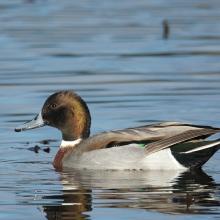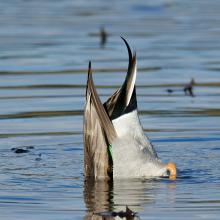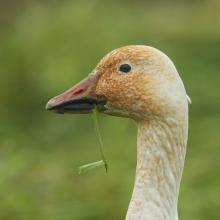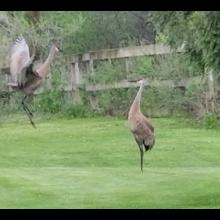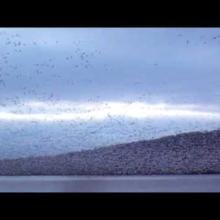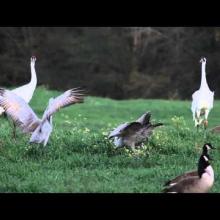

Join BirdNote tomorrow, November 30th!
Illustrator David Sibley and actor H. Jon Benjamin will face off in the bird illustration battle of the century during BirdNote's Year-end Celebration and Auction!
For 20,000 years, spring rains and melting snow have filled the playas of the Rainwater Basin of south-central Nebraska. As winter ends, 10 million waterfowl rest and feed there before continuing north. The seasonal wetlands form a funnel for birds heading from the Gulf Coast and points south to northern breeding grounds. In recent years, the number of Snow Geese stopping there in spring has risen dramatically to more than three million birds. A third of North America's Northern Pintails rely on the food-rich habitat there. Twenty-seven species of shorebirds use the wetlands, as well as half a million Sandhill Cranes.
BirdNote®
The Rainwater Basin of Nebraska
Written by Todd Peterson
This is BirdNote.
[Northern Pintails splashing in water]
For 20,000 years, spring rains and melting snow have filled the playas of the Rainwater Basin of south-central Nebraska. Carved by glacial winds at the end of the last Ice Age, the playas are shallow depressions the warmth of spring fills with abundant life. [Red-winged Blackbird] As winter ends, ten million waterfowl rest and feed here before continuing north.
[Calls of Northern Pintails, Blue-winged Teal with Mallards and marsh sounds]
The seasonal wetlands of the Rainwater Basin form a 150-mile-wide funnel for waterbirds migrating from the Gulf Coast and points south to northern breeding grounds. The basin is the narrowest neck of the great migratory route we call the Central Flyway.
[Calls of Snow Geese]
In recent years, the number of Snow Geese stopping in the region during spring has risen dramatically to more than three million birds. A third of North America’s Northern Pintails rely on the food-rich habitat here. [Northern Pintails] Shorebirds of 27 species use the wetlands. So do half a million Sandhill Cranes.
[Calls of Sandhill Cranes]
The importance of the region’s wetlands for waterfowl cannot be overstated. Fat reserves acquired during their stay here can mean the difference between success and failure in nesting. No other stopover between wintering and nesting grounds can replace the combination of wetlands and grain fields found in the Rainwater Basin.
[Calls of Sandhill Cranes]
For BirdNote, I’m Michael Stein.
###
Bird sounds provided by The Macaulay Library of Natural Sounds at the Cornell Lab of Ornithology, Ithaca, New York. Sandhill Cranes 2761 and Mallard males chattering 3430 recorded by A.A. Allen; marsh ambient 57508, Northern Pintail 43082 and Blue-winged Teal 66878 and Snow Geese 61210 recorded by W.W. H. Gunn. Red-winged Blackbird song by W.W. H. Gunn.
Producer: John Kessler
Executive Producer: Chris Peterson
© 2012 Tune In to Nature.org April 2012 / 2021 March 2024 Narrator: Michael Stein
ID# rainwaterbasin-01-2012-04-04 rainwaterbasin-01
1 and 2,/ Rainwater Basin Joint Venture website 3 and 4/ The American Bird Conservancy Guide to the 500 Most Important Bird Areas in the United States. 2003. Pages 164-165. Random House Trade Paperbacks. New York.




